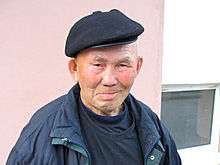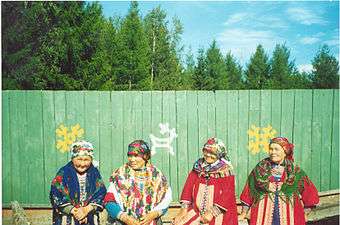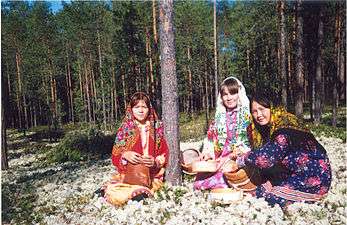Khanty
The Khanty (in older literature: Ostyaks) are a Ugrian indigenous people calling themselves Khanti, Khande, Kantek (Khanty), living in Khanty–Mansi Autonomous Okrug, a region historically known as "Yugra" in Russia, together with the Mansi. In the autonomous okrug, the Khanty and Mansi languages are given co-official status with Russian. In the 2010 Census,[1] 30,943 persons identified themselves as Khanty. Of those, 26,694 were resident in Tyumen Oblast, of whom 17,128 were living in Khanty–Mansi Autonomous Okrug and 8,760—in Yamalo-Nenets Autonomous Okrug. 873 were residents of neighbouring Tomsk Oblast, and 88 lived in the Komi Republic.
 Khanty from the Ob river | |
| Total population | |
|---|---|
| 31,000[1] | |
| Regions with significant populations | |
| Khanty-Mansi Autonomous Okrug (Russia) | |
| 30,943 (2010)[2] | |
| 100 (2001)[3] | |
| Languages | |
| Khanty, Russian | |
| Religion | |
| Russian Orthodoxy, Shamanism | |
| Related ethnic groups | |
| Mansi, Hungarians | |


.svg.png)
History
In the second millennium BC, the territories between the Kama and the Irtysh Rivers were the home of a Proto-Uralic-speaking population that had contacts with Proto-Indo-European speakers from the south.[4] The inhabitants of the areas were of Europid stock,[4] but the Khanty are predominantly Uraloid. The woodland population is the ancestor of the modern Ugrian inhabitants of Trans-Uralia.[4] Some consider the Khanty's ancestors to be the prehistoric metalworking Andronovo Culture. Other researchers say that the Khanty people originated in the south Ural steppe and moved northwards into their current location about 500 AD.[5]
Khanty probably appear in Russian records under the name Yugra (ca. 11th century), when they had contact with Russian hunters and merchants. The name comes from Komi-Zyrian language jögra ('Khanty'). It is also possible that they were first recorded by the English King Alfred the Great (ca. 9th century), who located Fenland (wetland) to the east of the White Sea in Western Siberia. The older Russian name Ostyak is from Khanty as-kho 'person from the Ob (as) River,' with -yak after other ethnic terms like Permyak.[6]
Some Khanty princedoms were partially included in the Siberia Khanate from the 1440s–1570s.
In the 11th century, Yugra was actually a term for numerous tribes, each having its own centre and its own chief. Every tribe had two exogamic phratries, termed mon't' and por, and all members were considered to be blood relatives. This structure was later replaced with clans, where each clan leader (knyazets) negotiated with the Russian realm. They also participated in Russian campaigns, and received the right to collect yasaq (tribute) from two Khanty volosts (districts) respectively. When this structure was no longer needed, Russia deprived them of their privileges.
Between the 17th and 19th centuries, there were attempts to introduce Christianity, but the Khanty lifestyle did not undergo any real changes. In the second half of 19th century, they gradually accepted state law.
During the Soviet period the Khanty were one of the few indigenous minorities of Siberia to be granted an autonomy in the form of an okrug (autonomous district). The establishment of autonomy has played a considerable role in consolidation of the ethnos (the Western Khants called their eastern neighbours Kantõk [the Other People]). However, in the 1930s concerted efforts were made by the Soviet state to collectivise them. The initial stages of this meant the execution of tribal chiefs, who were labelled "kulaks", followed by the execution of shamans. The abduction by the state of the children who were sent to Russian-speaking boarding schools provoked a national revolt in 1933 called the Kazym rebellion.
After the end of the Stalin period this process was relaxed and efforts were intensified in the 1980s and 1990s to protect their common territory from industrial expansion of various ministries and agencies. The autonomy has also played a major role in preserving the traditional culture and language.
Economy
The Khantys' traditional occupations were fishery, taiga hunting and reindeer herding. They lived as trappers, thus gathering was of major importance.
Organisation
The Khanty are one of the indigenous minorities in Siberia with an autonomy in the form of an okrug (autonomous area).
Religion
Most Khanty are today Orthodox Christians, mixed with traditional beliefs (shamans, reincarnation). Their historical shaman wore no special clothes except a cap. Traditional Khanty cults are closely related to nature. The Crow spring celebration is being celebrated in April, nowadays it is April 7, the same day as the Annunciation day. The Bear Celebration is being celebrated occasionally after a successful hunting of a bear. The Bear Celebration continues 5 or 6 days (the duration depends on the sex of the animal). Over 300 songs and performances occur during a Bear Celebration. The most important parts of the celebration are:
- Nukh Kiltatty Ar (The Awakening Song)
- Ily Vukhalty Ar (The Coming Down From The Sky Song) - The story about the son of Torum (the sky god). The son was sent by Torum to rule the Earth. He has forgotten father's advice, lost his immortality, turned into a beast and has been killed by the hunters.
- Il Veltatty Ar (The Lullaby)
Language
The Khanty language has long been thought to belong to a Ugric branch of the Uralic languages, and thus most closely related to Mansi and Hungarian, though that conclusion has come under doubt, with all three languages left unclassified within Uralic in some treatments. It consists of ten dialects, divided into southern, northern and eastern subgroups.
Notable Khanty
- Ambal (fl. 16th and 17th c.), Khanty and Tatar prince
Gallery
 Khanty children pose for the camera in front of a reindeer sledge near Lake Numto
Khanty children pose for the camera in front of a reindeer sledge near Lake Numto Khanty family at River Ob in the village of Tegi
Khanty family at River Ob in the village of Tegi Kazym grandmothers old women in Numsang Yoh nomad camp
Kazym grandmothers old women in Numsang Yoh nomad camp Khanty girls gathering berries
Khanty girls gathering berries.jpg) Khanty selling blueberries and stuffed animals
Khanty selling blueberries and stuffed animals
See also
Notes
- http://www.gks.ru/free_doc/new_site/perepis2010/croc/perepis_itogi1612.htm
- Официальный сайт Всероссийской переписи населения 2010 года. Информационные материалы об окончательных итогах Всероссийской переписи населения 2010 года [Official site of the National Population Census 2010. Informational materials about the final outcome Russian Census 2010] (in Russian). RU: GKS.
- "National composition of population". Census (in Ukrainian). UA: State statistics committee of Ukraine. 2001.
- Wiget, Andrew; Balalaeva, Olga (2011). Khanty, People of the Taiga: Surviving the 20th Century. University of Alaska Press. p. 3. ISBN 978-16022-3125-2.
- "Britannica".
- M. Vasmer, Etimologicheskii slovar russkogo yazyka, Vol. III (Moscow, 1971), p. 167.
External links
| Wikimedia Commons has media related to Khanty. |
- KHANTIA-MANSIA – YUGRA
- Khants — Some pictures of Khants' bird and fishery traps
- Redbook: The Khants
- Survival International
- Endangered Uralic Peoples: Khants or Ostyaks